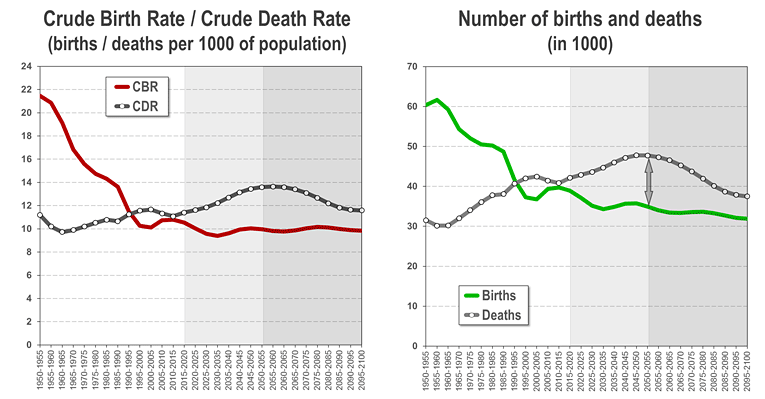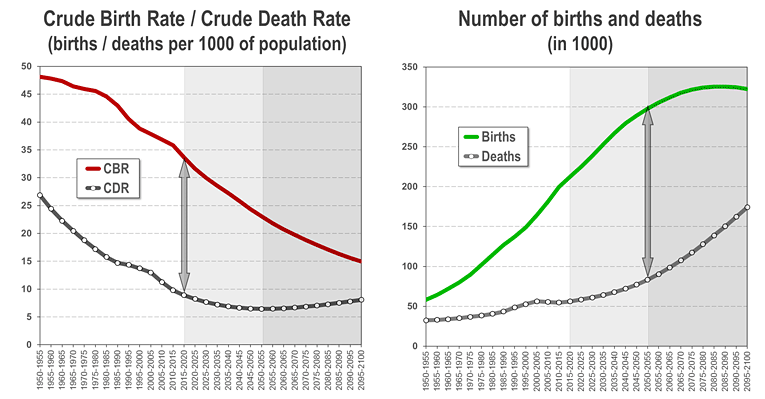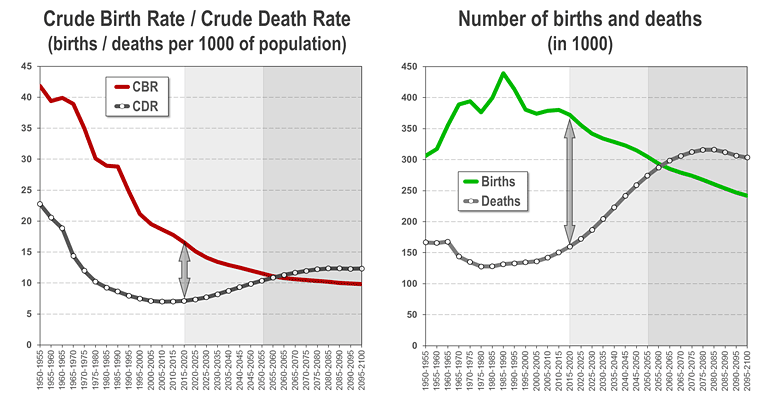
Births & Deaths
Updated: 22 December 2016
Europe: Births & Deaths, 1950-2100
Source: United Nations, WPP2015
In Europe, the crude birth rate had fallen from around 22 births per 1,000 of the population in 1950-1955 to the very low level of 12 births per 1,000 in 1990-1995. Today, the crude birth rate of Europe is less than 11 births per 1,000 of the population. The CBR is projected to fluctuate around 10 for the rest of the century. The crude death rate, however, has been increasing slightly since the early 1960s - from around 9.7 deaths per 1,000 of the population to 11 deaths per 1,000 today. On average, the death rate in Europe is now higher than the birth rate - indicating natural population decline.
The number of deaths in Europe is also higher than the number of births. The gap will increase in the future and peak between 2055 and 2060, when in this 5-year period 13.3 million more deaths than births will occur in Europe.
The number of deaths exceeds the number of births in Europe since the period of 1995-2000. Since then, Europe's population would decline without net-immigration from outside of Europe.*
The number of deaths in Europe is also higher than the number of births. The gap will increase in the future and peak between 2055 and 2060, when in this 5-year period 13.3 million more deaths than births will occur in Europe.
The number of deaths exceeds the number of births in Europe since the period of 1995-2000. Since then, Europe's population would decline without net-immigration from outside of Europe.*
Note: * The actual level of fertility as measured by the Net-Reproduction-Rate (in contrast to the CBR) has been below replacement in Europe since 1975-1980. Without age-structure effects natural population decline would have occurred around 20 years earlier in Europe. See chapter on the Net-Reproduction-Rate.
Literature:
United Nations, Department of Economic and Social Affairs, Population Division (2013) Fertility levels and trends as assessed in the 2912 Revision of World Population Prospects. New York, ST/ESA/SER.A/349
Africa: Births & Deaths, 1950-2100
Source: United Nations, PPP2015
The crude birth rate has been falling in Africa since the early 1950s - from around 48 births per 1,000 of the population to about 38 per 1,000 today. During the same time, the number of births have been increasing!
The seeming contradiction between falling births rates and increasing number of births has often confused the public as well as politicians. But it is a typical demographic process, which is caused by the very young, rapidly growing population in Africa. When very large cohorts of children and young adults enter the reproductive age, they will have a large number of children - even if the number of births in relation to the population declines.
Africa's crude birth rate is projected to fall further to 24 children per 1,000 of the population in 2050 - and to 15 births per 1,000 of the population by the end of the 21st century. The crude death rate has also declined significantly - from 27 deaths per 1,000 of the population to less than 10 deaths per 1,000 today. As significantly more people were borne than died, the population of Africa was growing rapidly.
In fact, the gap between births and deaths will be highest in Africa around 2055-2060, where, in a 5-year period, 305 million births, but "only" 90 million deaths will occur. This will cause the largest increase in Africa's population ever. In other words: Over the next 35 years the number of people added to the African population will grow and only peak around 2055-2060 with a 5-year population increase of around 215 million people.*
The seeming contradiction between falling births rates and increasing number of births has often confused the public as well as politicians. But it is a typical demographic process, which is caused by the very young, rapidly growing population in Africa. When very large cohorts of children and young adults enter the reproductive age, they will have a large number of children - even if the number of births in relation to the population declines.
Africa's crude birth rate is projected to fall further to 24 children per 1,000 of the population in 2050 - and to 15 births per 1,000 of the population by the end of the 21st century. The crude death rate has also declined significantly - from 27 deaths per 1,000 of the population to less than 10 deaths per 1,000 today. As significantly more people were borne than died, the population of Africa was growing rapidly.
In fact, the gap between births and deaths will be highest in Africa around 2055-2060, where, in a 5-year period, 305 million births, but "only" 90 million deaths will occur. This will cause the largest increase in Africa's population ever. In other words: Over the next 35 years the number of people added to the African population will grow and only peak around 2055-2060 with a 5-year population increase of around 215 million people.*
Note: * Actual population increase during the 5-year period of 2055-2060 is projected to be "only" 213 million, due to some net-outmigration.
Literature:
United Nations, Department of Economic and Social Affairs, Population Division (2013) Fertility levels and trends as assessed in the 2912 Revision of World Population Prospects. New York, ST/ESA/SER.A/349
Asia: Births & Deaths, 1950-2100
Source: United Nations, PPP2015
The crude birth rate has been falling in Asia since the early 1950s - from around 42 births per 1,000 of the population to about 18 per 1,000 today. It is projected to decline further to less than 10 births per 1,000 of the population by the end of the 21st century. Similarly, the crude death rate has also been falling in Asia - from 23 deaths per 1,000 of the population to just 7 deaths per 1,000 today.
Despite the decline in the crude birth rate, the number of births increased significantly in Asia - from around 306 million births in 1950-55 to about 439 million births in the 5-year period of 1985-90 (please note that the number of births refers to the full 5-year period). This increase in births was due to the young age structure of the population in the early 1950s. Subsequently the number of births declined to around 372 million in the 2010-2015 period (which is still higher than in the early 1950s).
However, from now on, Asia can expect declining numbers of births. By the end of the 21st century Asia might have some 242 million births per 5-year period. Both the crude birth and the crude death rate will then be very low. After the 2050 the crude death rate will be slightly higher than the birth rate - causing the population to decline.
Despite the decline in the crude birth rate, the number of births increased significantly in Asia - from around 306 million births in 1950-55 to about 439 million births in the 5-year period of 1985-90 (please note that the number of births refers to the full 5-year period). This increase in births was due to the young age structure of the population in the early 1950s. Subsequently the number of births declined to around 372 million in the 2010-2015 period (which is still higher than in the early 1950s).
However, from now on, Asia can expect declining numbers of births. By the end of the 21st century Asia might have some 242 million births per 5-year period. Both the crude birth and the crude death rate will then be very low. After the 2050 the crude death rate will be slightly higher than the birth rate - causing the population to decline.
Literature:
Gubhaju, Bhakta (2007) Fertility Decline in Asia: Opportunities and Challenges. The Japanese Journal of Population, Vol. 5, No. 1, 19-42
United Nations, Department of Economic and Social Affairs, Population Division (2013) Fertility levels and trends as assessed in the 2912 Revision of World Population Prospects. New York, ST/ESA/SER.A/349


